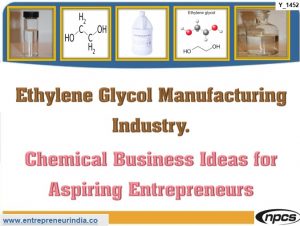Ethylene Glycol Manufacturing Industry

Ethylene Glycol Manufacturing Industry. Chemical Business Ideas for Aspiring Entrepreneurs
Ethylene glycol is a chemical commonly used in many commercial and industrial applications including antifreeze and coolant. Ethylene glycol helps keep car’s engine from freezing in the winter and acts as a coolant to reduce overheating in the summer. Other important uses of ethylene glycol include heat transfer fluids used as industrial coolants for gas compressors, heating, ventilating, and air-conditioning systems, and ice skating rinks.
Ethylene glycol also is used as a raw material in the production of a wide range of products including polyester fibers for clothes, upholstery, carpet and pillows; fiberglass used in products such as jet skis, bathtubs, and bowling balls; and polyethylene terephthalate resin used in packaging film and bottles. Many of these products are energy saving and cost efficient as well as recyclable.
In addition to its use in antifreeze, ethylene glycol is used as an ingredient in hydraulic fluids, printing inks, and paint solvents. It is also used as a reagent in making polyesters, explosives, alkyd resins, and synthetic waxes.
Ethylene glycol is a synthetic liquid substance that absorbs water. It is odorless, but has a sweet taste. Ethylene glycol is used to make antifreeze and de-icing solutions for cars, airplanes, and boats. It is also used in hydraulic brake fluids and inks used in stamp pads, ballpoint pens, and print shops.
Uses
Ethylene glycol has been most notably used as antifreeze in heating and cooling systems. It’s also been used as a de-icer for aircrafts as well as a de-icer for airport runways.
Other uses or places for ethylene glycol include but are not limited to:
- Within hydraulic brake fluids.
- As a solvent (dissolves another substance) for paint and plastic industries.
- To help make batteries
- To manufacture synthetic fibers, like Dacron
- To help make printer ink and ink for that ballpoint pen you recently used
- The most common use of ethylene glycol is in antifreeze formulation.
- Ethylene glycol also has a major use in the manufacture of polymers, namely polyethylene terephthalate (PET).
- EG used in the manufacture of fibre glass, which is used in things like, jet skis, bowling balls, storage tank and bath tubes.
- EG has been used to prevent and treat rot or fungi in wood. This is especially useful for museums where partially rotten wooden objects are displayed
Market Outlook
The global glycol market size was estimated at USD 30.41 billion in 2018. It is expected to expand at a CAGR of 6.7% from 2019 to 2025. Derivatives of glycol are used across a wide range of sectors that include automotive & transportation, food & beverage processing, heating, ventilation and air conditioning (HVAC), and polyester fibers.
Ethylene glycol is a crucial raw material for the production of PET resins and polyester fibers, which is why one of the main contributors for the growth of this segment is the growing demand for PET bottles from the packaging industry. One of the major consumers and growth drivers of ethylene oxide market globally is monoethylene glycol (MEG). It finds application in areas such as the production of films, bottles, polyester fibers and resins, as well as an antifreeze liquid and cooling agent in the automobile industry.
The key growth drivers of the market continue to be EG applications in packaging, polyester application in textiles, and as anti-freeze & coolants in automobiles. The growing demand will be further accentuated by capacity expansions in the Middle East and North America, with the Middle East contributing to a significant share in the export market. On the other hand, Europe and Asia would continue to experience a supply deficit of 6.6 MMT, and would be dependent on imports during the forecast period.
U.S. Glycol Market Demand, By Product, 2014-2025 (Kilotons)
Ethylene glycol is widely used as an antifreeze, coolant, and heat-transferring agent. In addition to its ability to bring down freezing point of fluids, the chemical also functions as a reagent in the production of polyesters, alkyd resins, synthetic waxes, and explosives. Furthermore, the ethylene-based glycols also find usage as an ingredient in printing inks, paint solvents, and hydraulic fluids.
Global Glycol Market Share, By Application, 2018 (%)
The most valued applications of the ethylene glycol market are polyester fibers, widely used in textile industries; PET resins, used for packaging of liquids and beverages in bottles; and automotive antifreeze, used in automobiles. The high demand across the industries for polyester fiber, PET resin, and automotive antifreeze will increase the overall ethylene glycol consumption.
The top players including:
- DOW Chemical
- Huntsman International
- Reliance Industries
- SABIC Innovative Plastics
- Sinopec
- Akzonobel
- BASF
- Clariant
- Shell
- Ineos Oxide
- Exxon Mobil
See more